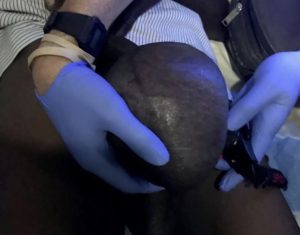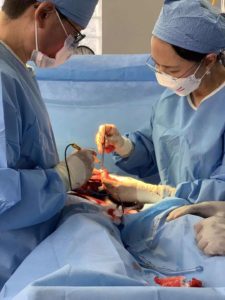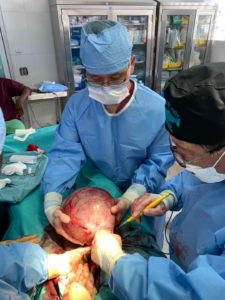By partnering with New Hope Hospital, Cap Haitien and Higgins Brothers Surgical Center, Fond Parisien, we have established the first special medical mission program “Make Men Smile®”. We can bring health and happiness to these patients. Surgical treatment of filariasis hydrocele is the most effective way to help thousands of male patients in Haiti.
Hydrocele disease

A hydrocele occurs when serous fluid accumulates inside the scrotum or along the spermatic cord. It may represent persistent developmental connections along the spermatic cord or an imbalance of fluid production versus absorptionan (idiopathic hydroceles) or unintended consequence of another medical procedure. Hydroceles can also be caused by injury, infection, inflammation or tumors of the testes.
In endemic tropical regions, such as Haiti, hydroceles may occur in males of any age as a result of lymphatic filariasis, a parasitic infection caused by a roundworm (nematode), Wuchereria bancrofti.
Hydroceles in Haiti

The causes, symptoms, and consequences of these hyderoceles in Haitian patients are completely different from those in the United States. Most of the hydroceles in American patients are caused by congenital reason, trauma and local inflammation. The hydroceles in Haitian is mainly due to a local special cause – filariasis!
Lymphatic filariasis is a mosquito-borne parasitic disease that causes severe lymphedema and scrotal hydrocele. Haiti is ravaged by filariasis throughout the country, with 88% of communities affected and 7.3% infected.
Filaria scrotal hydrocele is the main cause of disability and disfigurement, as well as economic losses, social stigma, family disharmony and sexual difficulty. It requires surgery (hydrocelectomy) to cure it.
Treatment of Filarial Hydrocele
 The method of radical filariasis is mass drug administration (MDA) and individual drug treatment. Filarial hydrocele requires surgery. An hour of hydrocele surgery will completely change the life of a Haitian man. As a result, hydrocelectomy helps the patients get rid of the pain caused by huge hydrocele, restore the labor force, and regain the role of the family backbone.
The method of radical filariasis is mass drug administration (MDA) and individual drug treatment. Filarial hydrocele requires surgery. An hour of hydrocele surgery will completely change the life of a Haitian man. As a result, hydrocelectomy helps the patients get rid of the pain caused by huge hydrocele, restore the labor force, and regain the role of the family backbone.
Filarial hydroceles are much more difficult to excise surgically than idiopathic hydroceles because of edematous tissue, scarring and fibrosis. The complete excision of entire tunica vaginalis is important to avoid hydrocele recurrence.
Based on Capuano ‘s clinical classification of filarial hydrocele , stage I or II hydrocele, associated with grade 0 or 1 penis burial, could be considered a simple hydrocele; A stage III or IV hydrocele associated with grade 2, 3 or 4 penis burial could be considered a complicated hydrocele. The complicated hydrocele usually requires a longer, more demanding operation with more intra-operative bleeding and could pose a higher risk for complications.
 Epididymectomy and Orchiectomy may need to be performed with hydrocelectomy together in some large cases of hydrocele.
Epididymectomy and Orchiectomy may need to be performed with hydrocelectomy together in some large cases of hydrocele.
Wound healing is slow and complicated in patients with filariasis because of the tissue lymphedema and chronic scarring. Patients who require excision of the scrotal skin (scrotoplasty) are at higher risk for bleeding and wound infection.
Antibiotics should be initiated the night prior to surgery and continue for about 5 days. The patients should be given the analgesics with nonsteroidal anti-inflammatory drugs or acetaminophen.
Patients with large filarial hydroceles are usually observed for 24-48 hours. Patients should return for a follow-up visit within 7 days.



